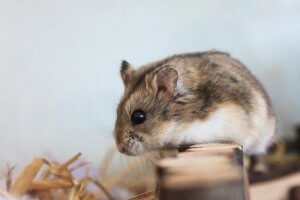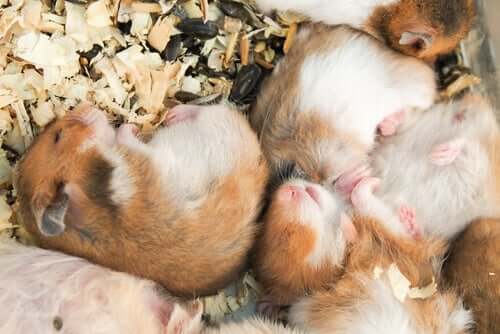The Life Cycle of Hamsters

These small rodents are popular pets, especially among children. They can live for approximately three years, a time during which they can reproduce several times. In this article, we’ll tell you all about the life cycle of hamsters.
The life cycle of hamsters
Of the almost 20 species of the Cricetinae subfamily, only a handful make for suitable pets since they’re easy to raise in captivity. All of them possess elongated cheek pouches in their mouths which extend to their shoulders. They accumulate food in these pouches, and females may even place their young in their pouches when they sense danger.
The life cycle of animals is as follows:
1. Birth
When hamsters come into the world, they can weigh between .07 and .10 ounces. At this time, they’re blind and deaf and their bodies are completely bald. What they do have when they’re born are the characteristic teeth of their species.

During the first week (minimum) after being born, it’s key that mothers aren’t bothered or “visited”, even by the father.
Upon the first sign of danger during this period, a mother’s first reaction will be to stuff her babies in her pouches and ingest them.
2. Development
Hamster babies grow very quickly. During their first week of life, they already eat solid foods–which is why they have teeth when they’re born. At the same time, they continue to consume their mother’s milk until they’re a month old.
On day 12, hamsters open their eyes and leave the cave or nest that their mother built. A short time later, they become independent and can leave their mother’s protection.
3. Adult age
Telling the difference between males and females is very simple. Males have large and noticeable testicles that becomes visible by the time hamsters reach their fourth week of life. This is when they reach sexual maturity.
It’s important to separate them by sex and place males and females in different habitats where they can live separately. That way, you’ll not only avoid fights, but also excessive proliferation. Some hamster owners form couples in order to perpetuate the species.
As for their habits, like the majority of rodents, hamsters are nocturnal or twilight creatures. They spend most of the day sleeping and wake up when the sun goes down. When they’re in captivity, they may enjoy entertaining themselves with toys, tunnels, and the typical hamster wheels.
4. Mating
As you can see, the life cycle of hamsters is quite “fast”, since they are already able to reproduce by the age of three months. In fact, females are fertile much sooner. The estrous or heat cycle lasts only four days. And, after nocturnal mating, which lasts half an hour, females move away from their mates.
Gestation is also short. Fetuses develop in 16 days, a time during which pregnant females are very sensitive. Therefore, it’s important to offer them a varied diet. What’s more, you should also offer them a variety of different materials–popsicle sticks, woodchips, alfalfa, etc. That way, they’ll have all they need when it comes to building their nests and giving birth to between 5 and 9 babies.
Just a few days after ceasing to nurse her babies, mothers go into heat again. If they become pregnant cycle after cycle, they’ll give birth every 2 months.
5. Old age
Since the life cycle of hamsters is so short, old age begins when these rodents reach their first year of age. From that time on, they are more prone to suffering illnesses. If they’re treated quickly, they may recover. Therefore, it’s key that owners take their hamsters to see a veterinarian regularly.
The most common pathologies in hamsters are stomach ulcers, cancer, and liver problems. The main cause of death is amyloidosis, a condition that affects many organs at the same time.
How long do hamsters live?
This is a very common question among those who want to adopt a hamster as a pet. It all depends on the type of hamster you’re dealing with, as well as the care the animal receives. Just the same, the approximate life expectancies are as follows:
- Golden or Syrian Hamsters: Between 2 and 3 years
- Winter white dwarf hamsters: 2 years
- Chinese hamsters: 3 years
- Roborovski dwarf hamsters: 3 years
- Campbell’s dwarf hamster: Between 1.5 and 2.5 years
These small rodents are popular pets, especially among children. They can live for approximately three years, a time during which they can reproduce several times. In this article, we’ll tell you all about the life cycle of hamsters.
The life cycle of hamsters
Of the almost 20 species of the Cricetinae subfamily, only a handful make for suitable pets since they’re easy to raise in captivity. All of them possess elongated cheek pouches in their mouths which extend to their shoulders. They accumulate food in these pouches, and females may even place their young in their pouches when they sense danger.
The life cycle of animals is as follows:
1. Birth
When hamsters come into the world, they can weigh between .07 and .10 ounces. At this time, they’re blind and deaf and their bodies are completely bald. What they do have when they’re born are the characteristic teeth of their species.

During the first week (minimum) after being born, it’s key that mothers aren’t bothered or “visited”, even by the father.
Upon the first sign of danger during this period, a mother’s first reaction will be to stuff her babies in her pouches and ingest them.
2. Development
Hamster babies grow very quickly. During their first week of life, they already eat solid foods–which is why they have teeth when they’re born. At the same time, they continue to consume their mother’s milk until they’re a month old.
On day 12, hamsters open their eyes and leave the cave or nest that their mother built. A short time later, they become independent and can leave their mother’s protection.
3. Adult age
Telling the difference between males and females is very simple. Males have large and noticeable testicles that becomes visible by the time hamsters reach their fourth week of life. This is when they reach sexual maturity.
It’s important to separate them by sex and place males and females in different habitats where they can live separately. That way, you’ll not only avoid fights, but also excessive proliferation. Some hamster owners form couples in order to perpetuate the species.
As for their habits, like the majority of rodents, hamsters are nocturnal or twilight creatures. They spend most of the day sleeping and wake up when the sun goes down. When they’re in captivity, they may enjoy entertaining themselves with toys, tunnels, and the typical hamster wheels.
4. Mating
As you can see, the life cycle of hamsters is quite “fast”, since they are already able to reproduce by the age of three months. In fact, females are fertile much sooner. The estrous or heat cycle lasts only four days. And, after nocturnal mating, which lasts half an hour, females move away from their mates.
Gestation is also short. Fetuses develop in 16 days, a time during which pregnant females are very sensitive. Therefore, it’s important to offer them a varied diet. What’s more, you should also offer them a variety of different materials–popsicle sticks, woodchips, alfalfa, etc. That way, they’ll have all they need when it comes to building their nests and giving birth to between 5 and 9 babies.
Just a few days after ceasing to nurse her babies, mothers go into heat again. If they become pregnant cycle after cycle, they’ll give birth every 2 months.
5. Old age
Since the life cycle of hamsters is so short, old age begins when these rodents reach their first year of age. From that time on, they are more prone to suffering illnesses. If they’re treated quickly, they may recover. Therefore, it’s key that owners take their hamsters to see a veterinarian regularly.
The most common pathologies in hamsters are stomach ulcers, cancer, and liver problems. The main cause of death is amyloidosis, a condition that affects many organs at the same time.
How long do hamsters live?
This is a very common question among those who want to adopt a hamster as a pet. It all depends on the type of hamster you’re dealing with, as well as the care the animal receives. Just the same, the approximate life expectancies are as follows:
- Golden or Syrian Hamsters: Between 2 and 3 years
- Winter white dwarf hamsters: 2 years
- Chinese hamsters: 3 years
- Roborovski dwarf hamsters: 3 years
- Campbell’s dwarf hamster: Between 1.5 and 2.5 years
All cited sources were thoroughly reviewed by our team to ensure their quality, reliability, currency, and validity. The bibliography of this article was considered reliable and of academic or scientific accuracy.
- Carleton, M. D. (1980). Phylogenetic relationships in neotomine-peromyscine rodents (Muroidea) and a reappraisal of the dichotomy within New World Cricetinae.
- Neumann, K., Michaux, J., Lebedev, V., Yigit, N., Colak, E., Ivanova, N., … & Gattermann, R. (2006). Molecular phylogeny of the Cricetinae subfamily based on the mitochondrial cytochrome b and 12S rRNA genes and the nuclear vWF gene. Molecular phylogenetics and evolution, 39(1), 135-148.
- Hurd, M. W., & Ralph, M. R. (1998). The significance of circadian organization for longevity in the golden hamster. Journal of biological rhythms, 13(5), 430-436.
This text is provided for informational purposes only and does not replace consultation with a professional. If in doubt, consult your specialist.








